Key Takeaways
- Volume measures the number of shares or contracts traded and helps gauge the strength of price movements.
- High volume confirms trends, while low volume may indicate a lack of market interest or potential reversals.
- Volume indicators help traders understand buying/selling pressure and validate price trends.
- Popular volume indicators include On-Balance Volume (OBV), VWAP, Chaikin Money Flow (CMF), and Money Flow Index (MFI).
- Using best volume indicators with price action analysis can improve trade timing and decision-making.
Do you know what a volume indicator is? Volume indicator analysis is an essential technical parameter that is ignored by traders, especially novice traders.
Volume plays an important role in technical analysis that helps confirm trends and patterns. It also indicates how many stocks were bought and sold in the market over a given period, so we can also take it as a market balance indicator. This helps us in gauging how other traders perceive the market.
One of the main benefits of volume is that it leads to the price movement of the stock, i.e., giving us early signals when the price movement is going to continue or reverse. Hence, volume-based indicators are useful measures for a trader.
Before discussing the 9 types of best Volume Indicators, let us know what the significance of high and low volume is in the stock market.
What is Volume?
Volume is the total amount of a security or item that is traded over time, frequently over a trading day. For instance, the number of shares traded between a stock’s daily open and close is referred to as its trading volume. Technical traders often use a volume trading indicator to analyse these changes, as it helps identify market strength, trend reversals, and potential entry or exit points.
Importance of High Volume
High volume indicates more interest in the stock and the presence of buyers and sellers in that stock. When the stock is in an uptrend, and there is an increase in volume along with the ongoing uptrend, the stock will continue to go up.
It indicates that more and more buyers are interested in buying that stock. Similarly, when the stock is in a downtrend, and there is an increase in volume along with the ongoing downtrend, the stocks will continue to go down.
As it indicates that more and more sellers are interested in selling that stock. From the daily chart of Reliance Ltd. We can see how increase in volume are leading the prices of the stock:
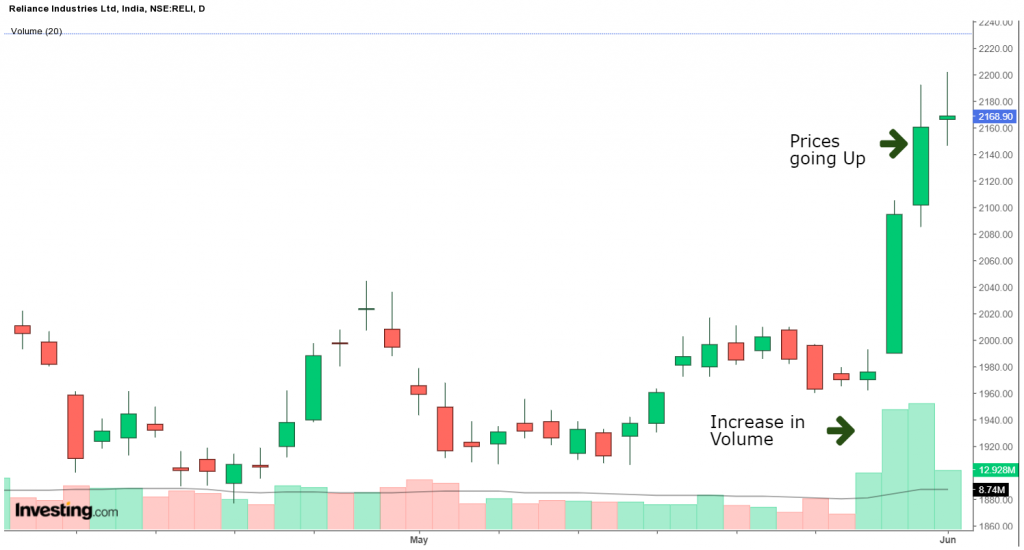
Importance of Low Volume
Low volume indicates a lack of interest in that particular stock.
When the stock is moving up and volume is falling then it indicates the interest of the buyers has reduced in the stock and the uptrend is going to reverse.
Similarly, when the stock is moving down and volume is falling then it indicates the interest of the sellers has reduced in the stock and the downtrend is going to reverse.
Below is a table which summarizes the above:
| Price | Volume | What is Expected |
| Up | Up | Bullish |
| Up | Down | Caution: weak hands buying |
| Down | Up | Bearish |
| Down | Down | Caution: weak hands selling |
Having understood the importance of high and low volume, let us now discuss the 9 types of best Volume Indicators that will help traders to analyse volume in trading.
Types of Volume Indicators
1. On-Balance Indicator
On Balance Volume (OBV) is the volume indicator that calculates the buying and selling pressure as a cumulative indicator which sums up volume on up days and subtracts volume on down days.
When the stock closes higher than the previous close, then all of the day’s volume is considered up-volume.
Similarly when the stock closes lower than the previous close, then all of the day’s volume is considered down-volume.
Rather than the value, one should focus on its direction.
- When both price as well as OBV are making higher peaks and higher troughs, then the upward trend is likely to continue as shown below:
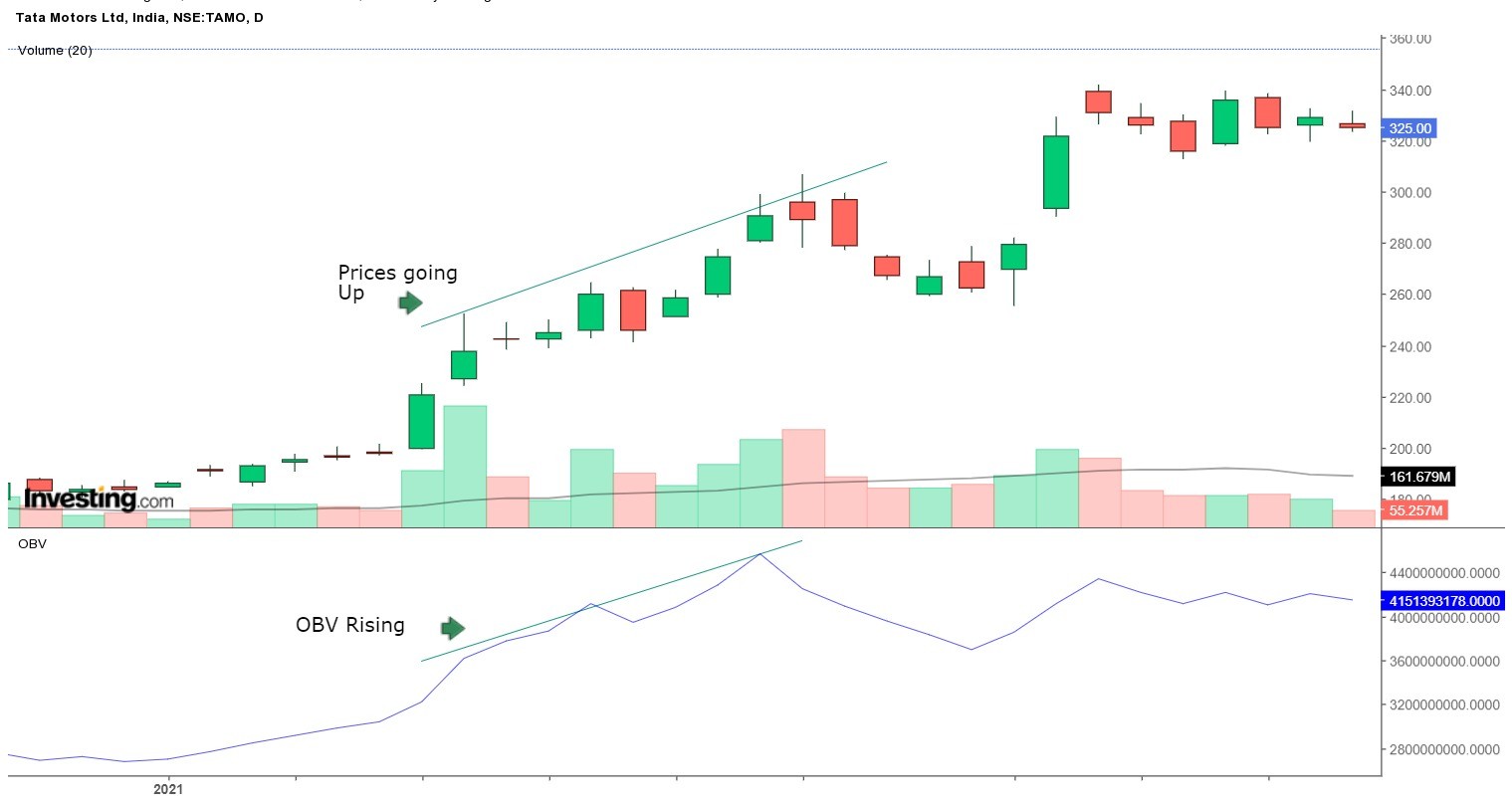
- When both price as well as OBV are making lower peaks and lower troughs, then the downward trend is likely to continue as shown below:
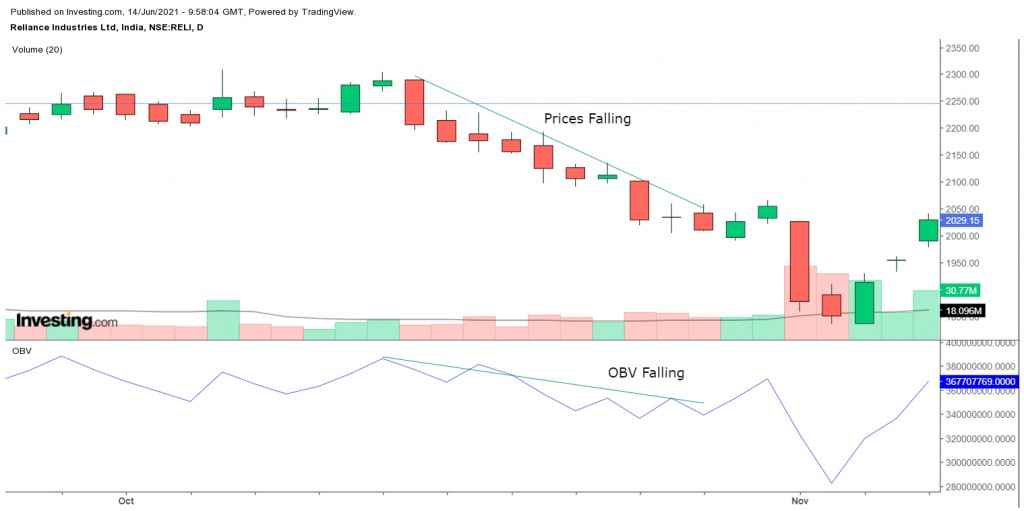
- When price continues to make higher peaks but OBV makes lower peaks, then the upward trend is likely to fail, known as negative volume divergence.
- When price continues to make lower troughs and OBV makes higher troughs, then the downward trend is to fail, known as positive volume divergence.
This indicator is calculated by adding the day’s volume to a cumulative total when the security’s price closes up, and subtracting the day’s volume when the security’s price closes down.
- If today’s close is greater than yesterday’s close, then: OBV = Yesterday’s OBV + Today’s Volume
- If today’s close is less than yesterday’s close, then: OBV = Yesterday’s OBV – Today’s Volume
- If today’s close is equal to yesterday’s close, then: OBV = Yesterday’s OBV
2. Volume RSI
The Volume RSI (Relative Strength Index) is a volume-based indicator that is similar to the Relative Strength Index, except that up-volume and down-volume are used in the formula of RSI instead of changes in price.
Volume RSI oscillates around 50% centre-line in the range from 0 to 100%.
One of the ways of using this volume indicator would be to trade on the signals generated on the crossovers of the indicator and the 50% center-line around which it oscillates.
- When the Volume RSI reading is above 50% then it is considered bullish indicating bullish volume dominates over bearish volume.
- When the Volume RSI reading is below 50% then it is considered as bearish indicating bearish volume dominates overbullish volume.
Thus, one should buy when indicators move above 50% line from below and sell when indicator drops below 50% line from above as shown in the daily chart of Bharat Heavy Electronics Ltd.
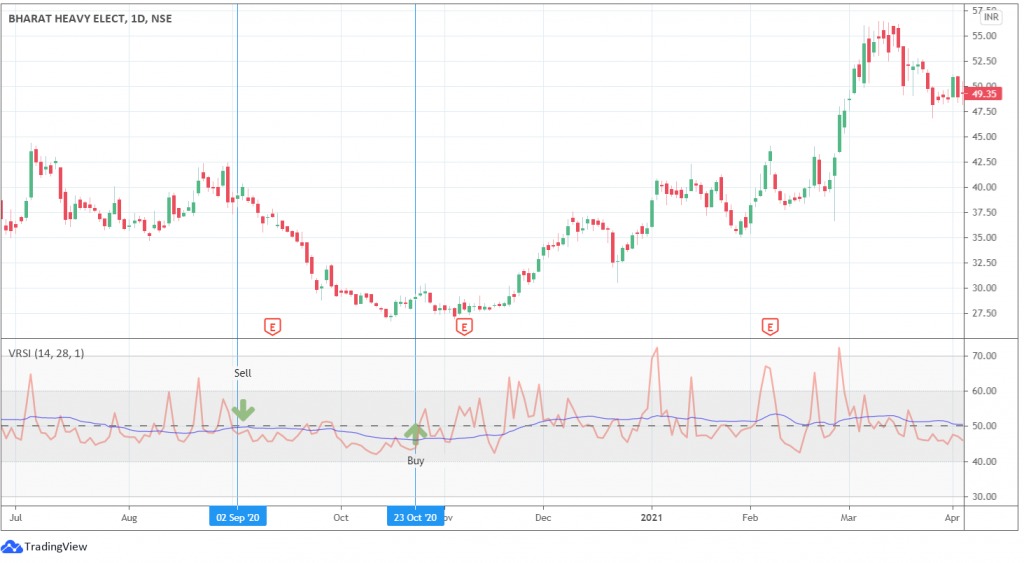
3. Volume Price Trend Indicator
The volume price trend (VPT) indicator is a volume indicator that helps in determining a stock’s price direction and also the strength of price change.
The indicator consists of a cumulative volume line that adds or subtracts a multiple of the percentage change in a share price’s trend and current volume, that is based on the security’s upward or downward movements.
This indicator is similar to the OBV (on-balance volume) indicator i.e. it measures cumulative volume and also provides traders with information about a security’s money flow.
The interpretations of the VPT can be summed up as follows:
- An increase in price and volume confirms the price trend upward.
- A decrease in price and volume confirms the price trend downward.
- An increase in price accompanied by a decreasing or flat volume trend is a negative divergence suggesting that the downward price movement is weak and may reverse.
- A decrease in price accompanied by an increasing or flat volume trend is a positive divergence suggesting that the upward price movement is weak and may reverse.
Below is daily chart of Bharat Heavy Electronics Ltd. which shows the VPT indicator:
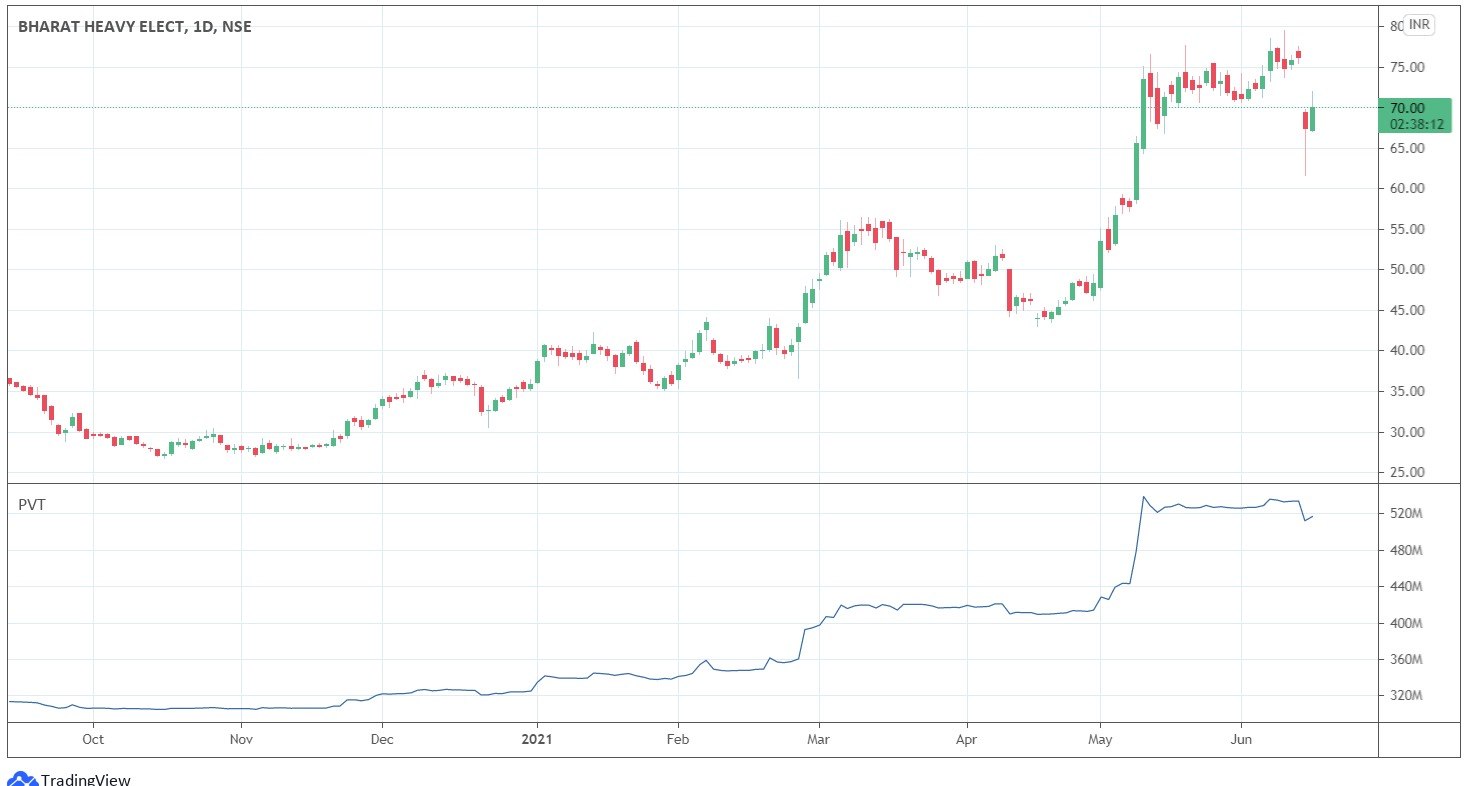
4. Money Flow Index
Money Flow Index (MFI) is a movement as well as volume indicator that analyses both time as well as price for measuring the trading pressure – buying or selling.
It is also known as the volume-weighted Relative Strength Index (RSI), as it also includes volume, unlike RSI which only incorporates price.
The formula for calculating MFI:
Typical Price = (High + Low + Close)/3
Raw Money Flow = Typical Price x Volume
Money Flow Ratio = (14-period Positive Money Flow)/(14-period Negative Money Flow)
Money Flow Index = 100 – 100/(1 + Money Flow Ratio)
The Money Flow Index (MFI) can be interpreted almost similarly to RSI. Trading signals are generated by this indicator when the stock signals bullish or bearish divergence, crossovers and when the stock is in the overbought or oversold zone as shown in the daily chart of Bharat Heavy Electronics Ltd.:
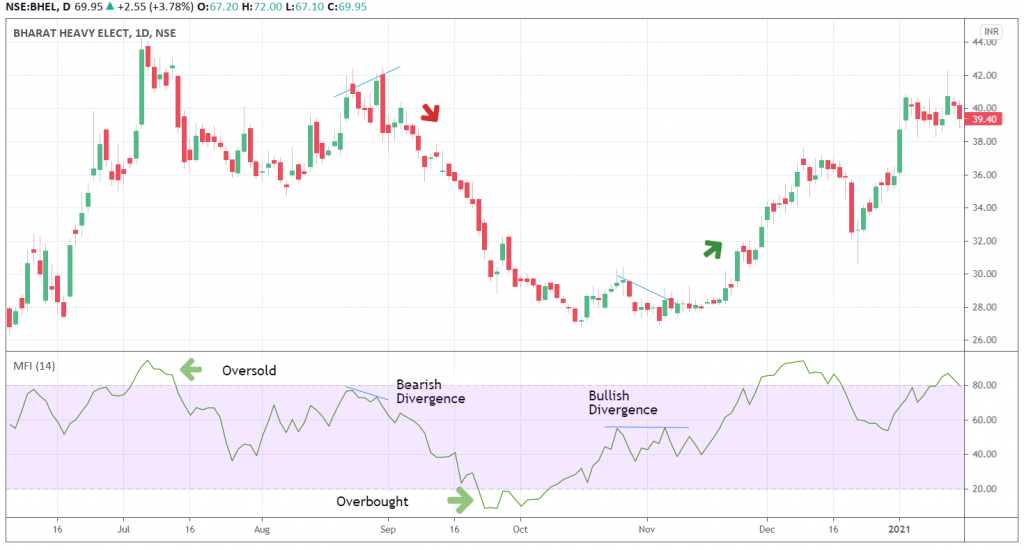
5. Chaikin Money Flow Indicator
The Chaikin Money Flow indicator is a volume trading indicator that helps in measuring the amount of Money Flow Volume over a particular period.
Chaikin Money Flow adds Money Flow Volume for a particular look-back period, typically 20 or 21 days. This indicator fluctuates above/below the zero line similarly like an oscillator.
According to this indicator, when the closing price is near to the high then more accumulation takes place. Similarly when the closing price is near to the low then more distribution takes place.
- A CMF value above the zero line signals strength in the market whereas a value below the zero line signals weakness in the market.
- One should wait for the CMF to confirm the breakout direction of price action, for example, if a price breaks upward through resistance, then one should wait for the CMF to have a positive value for confirming the breakout direction.
- A CMF sell signal occurs when price makes higher high into overbought zones, with the CMF diverging with a lower high which is known as negative divergence.
- A CMF buy signal occurs when price makes a lower low with the CMF diverging with a higher low with positive divergence.
From the daily chart of Bhel Ltd, we can see how after make bearish divergences prices of the stock fall down:
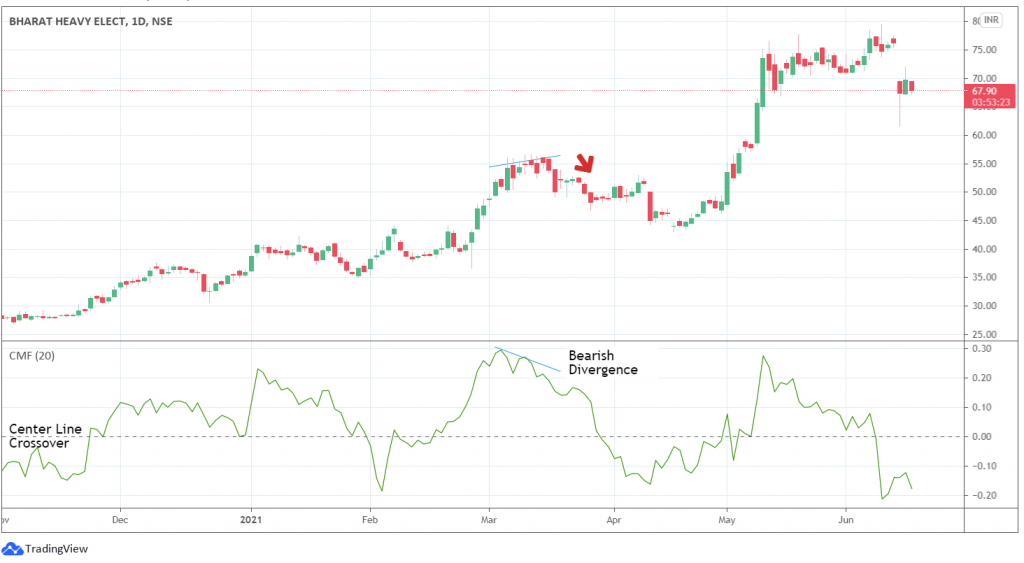
6. Accumulation/Distribution
The Accumulation Distribution Line is a volume indicator that measures the cumulative flow of money into and out of a stock.
A high positive multiplier with high volume indicates strong buying pressure which pushes the indicator higher. On the other hand, a low negative number with high volume indicates strong selling pressure which pushes the indicator lower.
This indicator tries to detect positive or negative divergences in price and volume data which signals an advanced warning of future price movements.
From the daily chart of Mphasis Ltd, we can see how after making bearish divergences prices of the stock fall down:
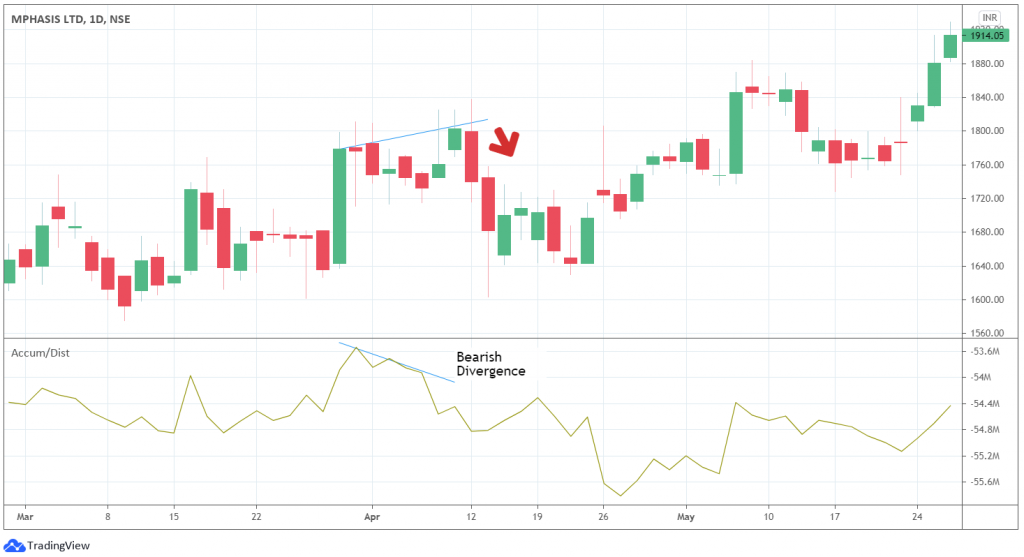
A trader who is accumulating stock is simply purchasing stock. Also, a trader who is sharing stock with the market is selling.
Thus, the accumulation/distribution indicator sizes up demand and supply, which drives price movement.
7. Ease of Movement
The Ease of Movement indicator another important volume indicator, helps in measuring the ‘ease’ with which a stock price moves between different levels based on volume trends. An easy-moving price is one which continues in its trend for a particular period.
This indicator works best in volatile markets where the trends cannot be clearly seen.
This indicator is best when it is used for longer time frames, like a daily chart as it identifies trends based on volume averages.
This indicator generates buy and sell signals when it crosses the 0 centreline or makes bearish or bullish divergences, as shown in the chart below:
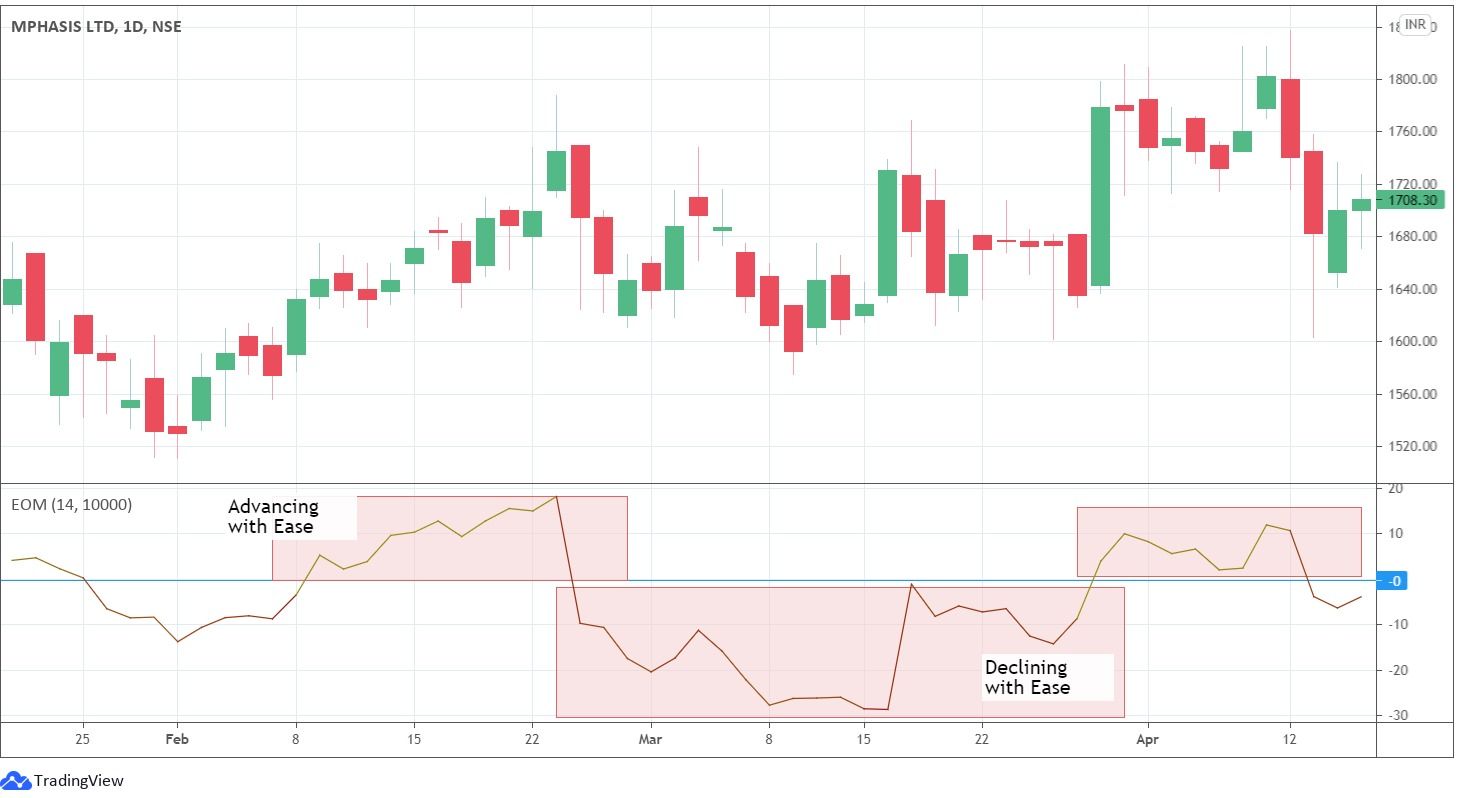
8. Negative Volume Index
The Negative Volume Index (NVI) is a cumulative indicator which uses the change in volume for deciding when the smart money is active.
This indicator works under the assumption that the smart money is active on days when volume decreases and the not-so-smart money is active on days when volume increases.
According to this indicator a bull market is when NVI is above its 255-day EMA and the bear market is when NVI is below.
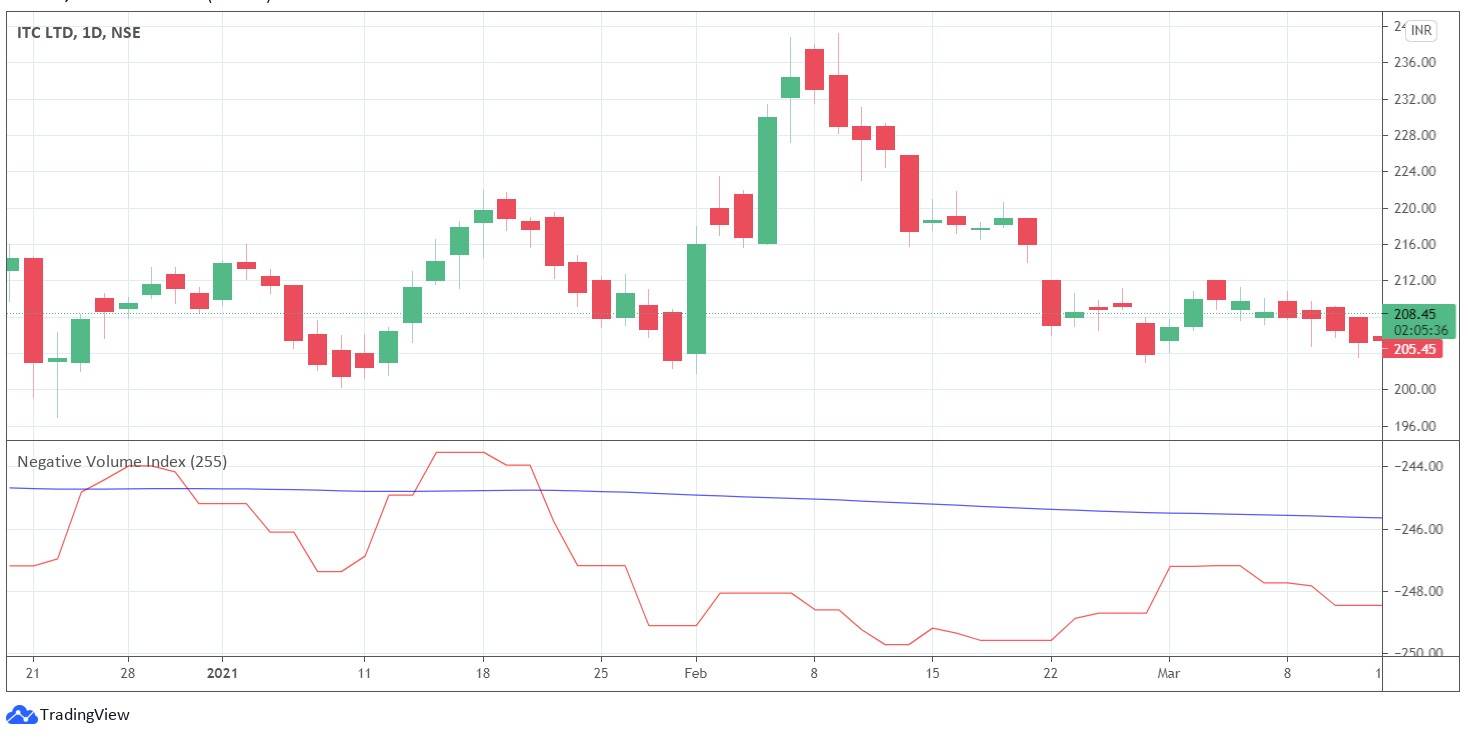
9. Volume-Weighted Average Price
The volume-weighted average price shows the average price an asset has traded at throughout the trading session when both the price as well as volume are considered.
This indicator shows the actual value the security is trading at, so it can signal if the security was bought or sold at a fair price.
Traders use the VWAP for eliminating the noise in the market to get an idea of what prices buyers and sellers are willing to transact.
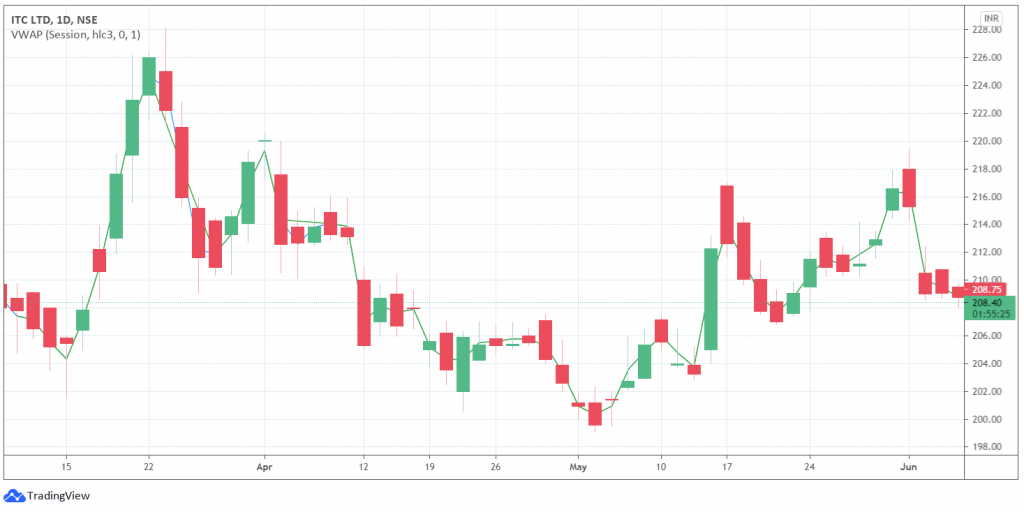
When the VWAP is rising or the price crosses above the VWAP line, then it shows that the prices are in an uptrend. Whereas if the VWAP is declining or the price crosses below the VWAP line, it shows that prices are in a downtrend.
Watch Our Video on Volume Indicators
Bottom Line
As discussed, stock market balance indicator analysis is a very important technical parameter to traders and investors. There are many volume indicators, but we have discussed some common and best volume indicators here. Traders should study these volume indicator settings and add them to their analysis tools to improve their trading.
Start volume analysis for free in StockEdge app.
Frequently Asked Questions (FAQs)
1. What is the best volume indicator?
PVI (Positive Volume Index) and NVI (Negative Volume Index) are the two most common and commonly utilised volume based indicators that support volume analysis. The positive volume indicator is intended to gauge how well or how much the trade volume has improved.
2. What are volume indicators?
To predict if price action is likely to continue or reverse, volume indicators examine trading volume. The on-balance volume (OBV), money flow, and rate of change are some of the frequently used volume metrics.
3. What is the best volume indicator for options trading?
The put-call ratio gauges the volume of trading in put options as opposed to call options. The variations in the put-call ratio’s value rather than its absolute value represent a shift in the mood of the market as a whole. It is among the best indicators for trading options.
4. Which indicator shows trade volume?
When major price changes and volume occur at the same time, the Trade Volume Index (TVI), a technical indicator, moves noticeably in the direction of a price trend. The TVI is often developed using intraday price data, in contrast to many other technical indicators.
5. How volume indicator work?
The volume indicator works by showing the total number of shares traded during a specific time. It helps you understand how strong a price move is. If volume is high, the move is strong. If volume is low, the move may not last.
6. How to read volume indicators?
To read a volume indicator setting, you need to look at how volume changes with the price. If the price falls and volume increases, it shows strong selling pressure. But if the volume is low during the fall, the trend may be weak. This helps you understand the strength behind the price move.
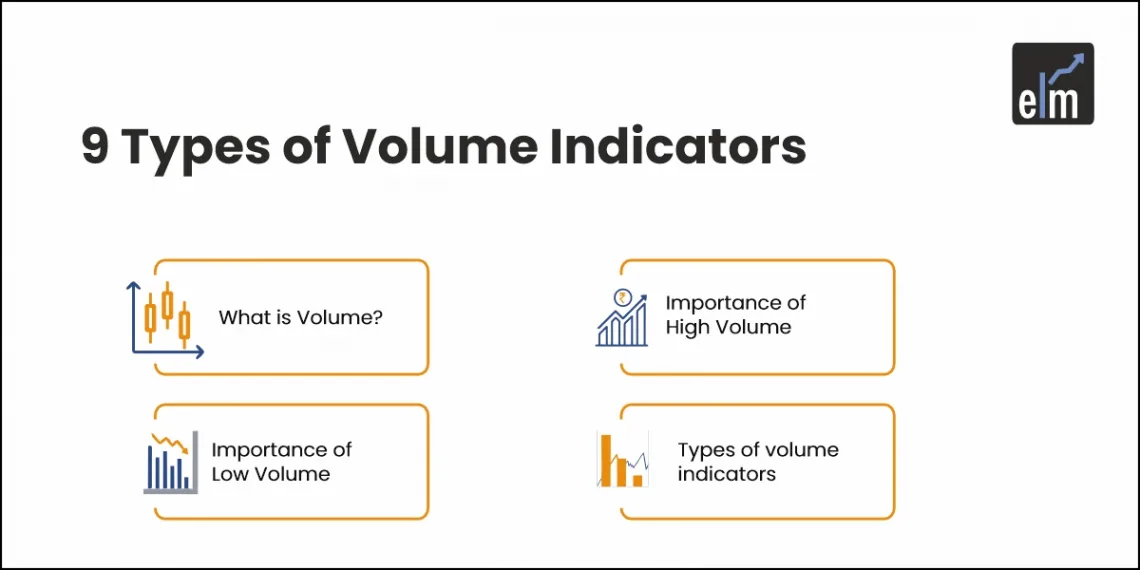

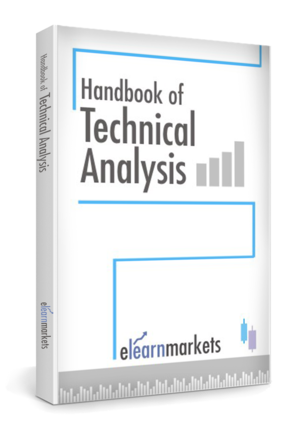



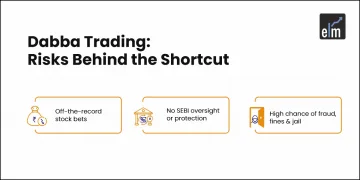

Thank you for sharing such important information. It will be very useful for us in future. Good
keep it up and keep writing.
Hi,
We are glad that you liked our post.
Thank you for Reading!
Very much informative.
Thank you
Hi,
We really appreciated that you liked our blog.
Keep Reading!!
Super content
Hi,
We really appreciated that you liked our blog.
Keep Reading!